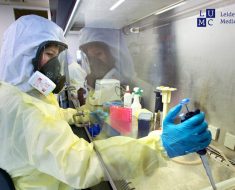NEW YORK (Reuters Health) – In experienced hands, first-line endoscopy with over-the-scope-clips (OTSC) outperforms standard endoscopic treatment in patients with acute non-variceal upper gastrointestinal bleeding (NVUGIB) at high risk of rebleeding, according to results of the German STING-2 trial.
The results complement findings from the STING-1 trial that found OTSC therapy to be more effective than standard endoscopy for recurrent peptic-ulcer bleeding.
STING-2 enrolled 100 patients (mean age, 78; 70% men) with endoscopic evidence of acute NVUGIB and high risk of rebleeding (defined as complete Rockall Score of 7 or higher), with 48 in the OTSC group and 52 in the standard-endoscopy group (all but one treated with conventional clips).
The clinical success rate – defined as successful endoscopic hemostasis without evidence of recurrent bleeding – was significantly higher in the OTSC group than the standard-endoscopy group (91.7% vs. 73.1%, P=0.019), Dr. Karel Caca with Klinikum Ludwigsburg and colleagues report in the journal Gut.
They say they chose with combined primary endpoint because “immediate and durable hemostasis is the most important outcome for the patients. This is also in accordance with international recommendations for studies on upper GI bleeding.”
They also observed a trend towards OTSC superiority at day 30. However, due to two late rebleedings in the OTSC group (day 10 and 14), the difference did not reach statistical significance (P=0.084). This may be due to the small sample size of the study, they note.
All six patients with persistent and five of eight with recurrent bleeding after standard endoscopy were successfully treated with OTSC therapy.
“In line with the STING-1 study, these results underline the efficacy of OTSC for difficult bleeding sources and endoscopic rescue strategy after failure of standard methods,” the researchers say.
They note that all endoscopists who participated in STING-2 were highly experienced in OTSC application.
In their clinical experience, “there certainly is a learning curve for OTSC application and associated accessories, especially for large lesions or lesions located at difficult positions,” they acknowledge.
They say further trials are needed to evaluate the possibility of a broader use of this “more complex and expensive hemostatic therapy and identify subgroups benefiting most from OTSC hemostasis.
The study had no specific funding. Several investigators have financial relationships with Ovesco Endoscopy AG, which markets OTSC therapy.
SOURCE: https://bit.ly/3DmvnNJ Gut, online March 23, 2022.
Source: Read Full Article





